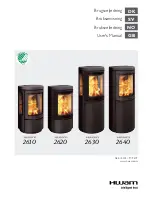
CAUTION!
NEVER USE GASOLINE, GASOLINE-TYPE
LANTERN FUEL, KEROSENE, CHARCOAL
LIGHTER FLUID, OR SIMILAR
LIQUIDS TO START OR "FRESHEN UP" A
FIRE IN THE HEATER. KEEP ALL SUCH LIQUIDS
WELL AWAY FROM THE HEATER WHILE IT IS IN
USE
CAUTION!
USE WOOD OR WOOD-LIKE MATERIALS
ONLY. DO NOT USE COAL OR
CHARCOAL. COAL OR CHARCOAL WILL
DESTROY THE FIREBOX. DO NOT USE
DRIED LUMBER OR TREATED WOOD.
9
WARNING!
NEVER STORE FLAMMABLE LIQUIDS,
ESPECIALLY GASOLINE. IN THE
VICINITY OF THE HEATER.
CAUTION!
OVERFIRING THE APPLIANCE MAY
CAUSE A HOUSE FIRE. IF A UNIT OR
CHIMNEY CONNECTOR GLOWS, YOU
ARE OVERFIRING.
WARNING!
NEVER OPERATE THIS HEATER WITH THE FUEL
DOOR OPEN.
NOTE:
DO NOT ELEVATE FIRE OR USE WITH A GRATE -
BUILD FIRE DIRECTLY ON THE HEARTH.
Chimney Maintenance
Creosote - Formation and Need for Removal
When wood is burned slowly, it produces tar and other organic
vapors, which combine with expelled moisture to form creosote.
Th
e creosote vapors condense in the relatively cool chimney fl ue of
a slow-burning fi re. As a result, creosote residue accumulates on the
fl ue lining. When ignited this creosote makes an extremely hot fi re.
Th
e chimney connector and chimney should be inspected at least
twice monthly during the heating season to determine if a creosote
buildup has occurred.
If creosote has accumulated, it should be removed. Failure to re-
move creosote may cause a house fi re. Creosote may be removed
by using a chimney brush or other commonly available materials.
Chimney fi res burn very hot. If the chimney connector should glow
red, immediately call the fi re department, then reduce the fi re by
closing the inlet air control and pour a large quantity of coarse salt,
baking soda or cool ashes on top of the fi re in the fi rebox. CAU-
TION: A chimney fi re may cause ignition of wall studs or raft ers
which you thought were a safe distance from the chimney. If you
have a chimney fi re, have your chimney inspected by a qualifi ed
person before using again.
Service Hints
Do not expect a heater to draw. It is the chimney that creates the
draft . Smoke spillage into the house or excessive buildup of water
or creosote in the chimney are warnings that the chimney is not
functioning properly. Correct problem before using heater. Pos-
sible causes are:
Th
e connector pipe may be pushed into the chimney too far,
stopping the draft . (Fig. 7)
Do not connect two heaters into the same chimney fl ue.
Th
e chimney used for a heater must not be used to ventilate
the cellar or basement. If there is a cleanout opening at the
base of the chimney, It must be closed tightly.
1.
2.
3.
4.
5.
If the chimney is operating too cool, water will condense in
the chimney and run back into the stove. Creosote formation
will be rapid and may block the chimney. Operate the heater
at a high enough fi re to keep the chimney warm preventing
this condensation.
If the fi re burns well but sometimes smokes or burns slowly, it
may be caused by the chimney top being lower than another
part of the house or a nearby tree. Th
e wind blowing over a
house or tree, falls on top of the chimney like water over a dam,
beating down the smoke. Th
e top of the chimney should be at
least 3 feet above the roof and be at least to 2 feet higher than
any point of the roof within 10 feet (Fig. 6).
WARNING!
USE ONLY THE LEGS PROVIDED WITH THIS
HEATER. REFER TO STEP 5 IN THE "INSTALLATION"
SECTION OF THIS MANUAL.
WARNING!
DO NOT OBSTRUCT THE SPACE BENEATH THE
HEATER






























